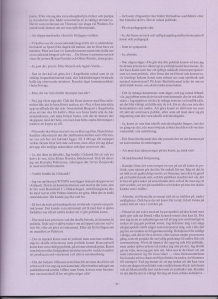Below is the Swedish version of our short interview with Lene Berg, the filmmaker behind Stalin By Picasso. We’ll try to work out an English translation shortly. Stalin by Picasso or Portrait of Woman with Moustache will be screened during a presentation of the Sunshine Socialist Cinema during the Socialist Forum in Stockholm on Saturday December 1 2012. Check out previous posts or the Program-page for more info on the screening. Huge thanks to Lene Berg for doing the interview.
1. Vad ser du som det centrala motivet i din film? Vari består konflikten mellan konstnären och partiet, vad ligger till grund för konflikten? Vilka olika syner på vad konst är och gör?
Min första reaktion på Picassos porträtt av Stalin var att det var komiskt, på alla sätt. Det liknar inte Stalin, och det liknar inte heller Picasso. Det skorrar med allt man vet om båda männen. Sådana oöverensstämmelser intresserar mig. När jag senare läste om kontroversen porträttet väckte 1953 tyckte jag att argumenten var intressanta. Man sa att porträttet inte var tillräckligt heroiskt, att Picasso inte var bra nog att rita den store Stalin, att han inte hade förmågan att se och tänka som vanliga människor. Argumenten påminde om saker jag hört tusen gånger i diskussioner om statlig kulturpolitik till exempel, där man talar om “vad folk vill ha” som att det är något självklart och statiskt. Eftersom objektet här är Stalin och eftersom uppfattningen om Stalin har ändrats en hel del sen 1953, får argumenten en lite annan klang än i nutida diskussioner om vad folk vill ha. Sett med nutida ögon kan man säga att Picasso var intelligent nog att inte följa sina kamraters smak och åsikter. Samtidigt tyder inget på att han önskade att provocera, snarare tvärt om, och han fattade inte att han gjort det innan han och porträttet fördömdes offentligt. Kanske kan man säga att det handlar om konflikten mellan en konstnärlig inställning och en ideologisk inställning. Poeten Louis Aragon, som var högt uppe i det franska kommunistpartiet, valde att foga sig till partilinjen och ångrade offentligt att han publicerat porträttet. Picasso å andra sidan bad aldrig om ursäkt, även om kritiken sårade honom. Jag vet inte om det här beskriver det centrala motivet i filmen, men någonstans här låg den första impulsen.
2. Vi kände inte till historien om Picassos porträtt av Stalin förrän vi såg din bok på Konsthall C i våras. Historien är för oss både intressant som diskussionsunderlag, och gripande i de känslor som väcks. Vilka reaktioner har du fått på filmen när den visats tidigare? Från publik, press/debattörer, institutioner eller myndigheter? Och från människor som jobbar/är aktiva i vänsterorganisationer och radikala politiska partier?
Generellt har projektet fått mycket positiva reaktioner, det har visats en hel del och i många olika sammanhang och länder, såsom Indien, Taiwan och Ryssland. Det vill säga filmen och boken. Men när jag ville hänga ett fasadbanér med Picassos teckning utomhus i samband med utställningar blev det bråk. I Oslo blev projektet stoppat, även om banéret bara skulle hänga i 24 timmar. I New York skulle det hänga i sex veckor, men de tog ner det efter två dagar. Det visade sig att när det här porträttet visas i ett offentligt rum, utanför en konstkontext, läses det som propaganda, eller som reklam. Även om jag tycker det är uppenbart att teckningen inte är någon enkel hyllning till Stalin, något dåtidens franska kommunister skulle hålla med mig om, uppfattades den av många som det. Jag blev lite överraskad över de starka reaktionerna. Min intention var inte att diskutera Stalin, men snarare att lägga något till den ganska stela macho-myten som Picasso blivit och på så sätt bidra till en bredare diskussion om konst och politik. Jag försökte säga till Cooper Union (som tog ner banéret i New York) att de hade tagit ner Picasso och inte Stalin från sin fasad. Men de trodde mig inte, de trodde jag skojade. Skillnaden på hur man läser en bild innanför och utanför “konstrummet” chockerade och överraskade mig egentligen. Det gjorde också att jag kände stor sympati med Picasso och hans inställning under den kontrovers han var med om 1953.
3. Med filmens Picasso i åtanke – hur vill du att din egen film skall fungera som konstverk, och i vilket sammanhang? Vad skulle den kunna tillföra, inom vilken gemenskap?
Jag vet inte hur jag ska svara på en sådan fråga. Kanske finns det ett svar, men det är svårt att skriva eller uttala det utan att riskera att det går förlorat.




